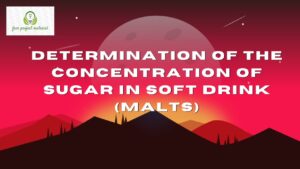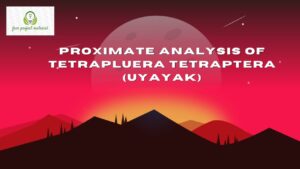ABSTRACT
The concentration of trace metals in water from Abiakpo Ntak Inyang stream, Ikot Osurua, Ikot Ekpene, Akwa Ibom State, Nigeria were analyzed using atomic absorption spectrophotometer (AAS). The results of the analysis showed the concentration of the trace metals to be Fe (12.528 0.120 mg/l), Zn (4.186 120mg/l) Cd (1.880 0.004 mg/l), Ni (0.065 0.006 mg/l), Pb (0.240 0.035mg/l) and Cr (1.501 0.221 mg/l). The results also revealed that the concentration of the trace metals follow the trend Fe> Zn > Cd > Cr > Pb > Ni. All the investigated metals were above the United States Environmental Protection Agency (USEPA) limit except Pb and Ni. Thus calls for regular monitoring of the surface water to avoid human health risk.
TABLE OF CONTENTS
Title page – – – – – – – – – i
Certification – – – – – – – – – ii
Dedication – – – – – – – – – iii
Acknowledgement – – – – – – – – iv
Abstract – – – – – – – – – v
Table of Contents – – – – – – – – vi-vii
CHAPTER ONE: INTRODUCTION
1.1 Background of the Study – – – – – – 1-2
1.2 Aims and Objectives of the Study – – – – 2
1.3 Scope and Limitation of the Study – – – – 2-3
CHAPTER TWO: LITERATURE REVIEW – – – 4
2.1 Trace Metals – – – – – – – 5
2.2 Sources of Trace Metals – – – – – – 5
2.2.1 Natural Source – – – – – – – 5-6
2.2.2 Anthropogenic Source – – – – – – 6-7
2.3 Behaviour of Trace Metals in the Environment and their Uses – 7-10
2.4 Trace Metals and their Uses – – – – – 10
2.4.1 Lead (Pb) and its Uses – – – – – – 11
2.4.2 Cadmium (Cd) and its Uses – – – – – 11
2.4.3 Iron (Fe) and its Uses – – – – – – 12
2.4.4 Zinc (Zn) and its Uses – – – – – – 12
2.4.5 Nickel (Ni) and its Uses – – – – – – 13
2.4.6 Chromium (Cr) and its Uses – – – – – 13
2.5 Health Effects of Trace Metals – – – – – 14
2.5.1 Health Effect of Lead – – – – – – 14
2.5.2 Health Effect of Cadmium – – – – – 14-15
2.5.3 Health Effect of Iron – – – – – – 15
2.5.4 Health Effect of Zinc – – – – – – 15
2.5.5 Health Effect of Nickel – – – – – – 16
2.5.6 Health Effect of Chromium – – – – – 16
CHAPTER THREE: MATERIALS AND METHOD
3.1 Materials and Reagents – – – – – – 17
3.2 Methods – – – – – – – – 18
3.2.1 Sample Collection and Preparation – – – – 18
3.2.2 Digestion of the Sample – – – – – – 18
3.2.3 Determination of Sample Using
Atomic Absorption Spectrophotometer (AAS) – – 18-19
CHAPTER FOUR: RESULTS AND DISCUSSION
4.1 Results – – – – – – – – 20
4.2 Discussion – – – – – – – – 21-27
CHAPTER FIVE: CONCLUSION AND RECOMMENDATION
5.1 Conclusion – – – – – – – – 28
5.2 Recommendation – – – – – – – 28
References
CHAPTER ONE: INTRODUCTION
1.1 Background of the Study
Trace metals are inorganic micro-nutrients that are required by humans in very low concentrations. They acts as cofactors for the proper functioning of many enzymes and other proteins (Oti-Wuberferce, 2015).
Trace metals enter into aquatic system by natural and anthropogenic sources. During the last two centuries, trace metals released by anthropogenic influence have superimposed its contribution by natural source (Bodaghpour et al., 2012). Water pollution because of these elements is the major environmental problem as well as socio- economic problem.
Water is the most important natural resource on earth. It is essential for all known forms of life and is approximated to over 70.9% of the earth surface (Foster, 2001). Despite its abundance, the quality and accessibility of potable water remains a global challenge: Moreso, in rural and semi- rural communities in the developing countries (Faemi and Oloyede, 2010; Foster, 2001). Poor water quality continues to pose major threats to human health. Njoku (2012) noted that communicable disease which is transmitted by water include bacteria, viral and protozoa infections. This bacteria disease include: typhoid, paratyphoid, samonclosis shigellosis, dysentery and Asiatic cholera, viral diseases associated with water include: hepatitis, poliomyelitis and those cases by gastroeruerlitis attributed to Norwalk. Protozoa such as giardia and cryptosporidium can produce gastroenteritis and are much resisted to disinfectants.
1.2 Aim and Objectives of the Study
The aim of this research work is to analysis some trace metals in water from Abiakpo stream.
The objectives were:
- To determine the level of Pb, Cd, Fe, Ni, Cr and Zn in water from Abiakpo stream.
- To compare the level of these metals with the permissible standard.
- To compare the level of these metals with other research work.
- To make recommendation for future studies based on this study.
1.3 Scope and Limitation of the Study
This study focuses on the analysis of trace metals in water from Abiakpo stream.
The studies on the physicochemical parameters of water and organic pollutants will not be considered in this study due to time and financial constraint.
The study is limited to the analysis of Pb, Cd, Fe, Ni, Cr and Zn.


